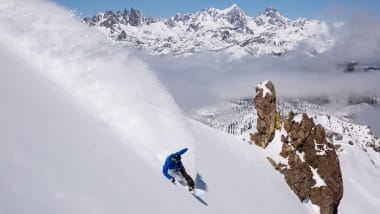
Cross-country ski tracks consist of parallel lines made on a snow surface using specialized grooming machinery. These grooming machines move, push, flatten and smooth the snow for skiing and skate skiing.
Cross country skiing requires special skills such as grooming the trails. You need to be familiar with snow movement, ski tracks and terrain. In addition to creating ski tracks, the groomers also shape the ski base and reduce friction between the ski and the snow.
Learn about cross country skis
The first step to mastering cross-country skiing is to find the right equipment. Eastern Mountain Sports is able to help you select the right ski package, which will include the right boots as well as bindings and poles.
Pick the best pair of skis you can afford
When it comes to choosing a set of skis, it's important to get a pair that is sized properly for your weight. You should have enough length to comfortably fit your legs and arms while standing in your normal stance (bending at your ankles and knees with your hands slightly in front).

A lightweight pair of skis will help you glide quickly across the snow without slipping. This is a great choice for anyone who likes to be outdoors and enjoy winter's natural beauty.
Use the shuffle.
This basic kick-and glide skiing technique can be practiced by lowering your pole tips into the snow, so that they are directly below your arms. This activates your core muscles, and helps you maintain your balance on the ski.
Keep going until you feel comfortable with the basic shuffle and glide motion. Add a poling motion when you feel confident with the basic shuffle/glide. This moves your ski pole tip straight down into snow.
The poling motion is an excellent way to improve your technique. This is an excellent technique that beginners can learn, and it can improve your overall skiing performance.
Use the correct technique for your skill level
There are three types of cross-country skiing: classic, touring, and skating. Each technique will require a different set or skis, depending on how you want to ski on the surface.

Touring skis will help you glide more easily on a flat surface, while classic skis will help you move more quickly over slopes and through deeper snow. Skating skis will help you speed up over a softer surface, while classic skis are more for beginners and beginner-intermediate levels of skiing.
As you get more proficient and confident, start with a flat track that is easy to navigate. Then move on to more difficult trails. Always be alert for motorized vehicles as well as trail groomers when you are on cross country ski tracks. If they approach you from behind or heading your way, you should get off the tracks.
FAQ
How much luggage should I take with me?
The length of your trip will determine how much luggage you need. You will only need to bring hand luggage if you're traveling by plane. This is typically less than 20kg. If you're traveling by bus or train, you'll need more space.
A form will be provided to you when you arrive at the airport with information about your flight. This will include information like the weight of your bag and whether you need assistance in checking them in.
This must be done before you leave your home. If you don’t check it, you might end up waiting hours for everyone else to do so.
Traveling light is the best option, because you never really know what could happen. You won't be able to use your bag if it gets lost.
Should I purchase travel insurance?
Travel insurance is essential for anyone who plans to go on an adventure. It's important that you are covered for all kinds of adventure sports.
If you're skiing, for example, it is important to have medical coverage. You should also think about getting coverage for theft loss and damage.
Also, you should consider purchasing cancellation insurance. This allows you to cancel your holiday without having to pay any penalties.
You should also ask for coverage for emergency evacuation. This includes being taken off the mountain in case of an avalanche or other natural disaster.
How do you travel light?
There are no right or wrong answers when packing for a vacation. These tips will help guide you in choosing what to bring on your trip.
-
Bring only what you really need.
-
You should only pack what you actually wear.
-
Don't overload yourself with too many items.
-
Take enough room in your suitcase
-
Always double-check that you've packed everything you need.
-
You can take advantage of our free storage facilities
-
Instead of purchasing bottled water, use reusable water bottles.
-
You can carry a backpack rather than a suitcase.
-
Take public transport if possible and instead walk or bike.
-
You can choose the right size bag.
-
Avoid carrying heavy objects.
-
Prepare for anything.
-
Nothing should be left behind
Statistics
- They're also likely to offer babysitting services, in case you'd like to have dinner one night after 7 p.m. (travelandleisure.com)
- No Checked Bags: No Alcoholic beverages with more than 70% alcohol (over 140 proof), including grain alcohol and 151 proof rum. (tsa.gov)
- Between the ages of 11 and 13, kids, or tweens, will likely want some autonomy but also need boundaries. (travelandleisure.com)
- Case in point: the private island of Ilha Caldeira, less than seven miles off the coast as part of the Primeiras and Segundas Archipelago, is located within the marine-protected area with 20 percent of the country's intact living coral. (travelandleisure.com)
- You can use compression sacs or cubes to reduce the volume of your clothes by up to 80%—this is especially convenient for bulky items such as sweaters and jackets. (eaglecreek.com)
External Links
How To
How to Enjoy Weekend Vacations
A weekend away is an opportunity for reflection, relaxation, and enjoyment. It's a time to unwind, recharge, and disconnect.
This is also a time for reflection on your priorities and how you spend your weekends. If you have the opportunity to travel for work, you may find yourself reflecting upon what makes it so rewarding.
Whatever reason you have for taking a vacation from the office, plan plenty activities.
You'll likely want to relax on your own while enjoying the company of friends and family back home. However, it is important to stay active.
Whether you choose to explore local attractions, go hiking or camping, or simply soak up some sun, there are lots to do when you're on the road.
You should also allow yourself plenty of time to relax and recover after each activity. You can easily burn out if your body is constantly working hard. Plan ahead and allow for some downtime.
Once you've landed safely, you'll probably look forward to relaxing again. It won't take long for you to be eager to get back on the ground.
Don't let yourself fall behind. Make sure you set aside time daily to catch up on emails and projects.
This way, you'll stay connected without feeling overwhelmed. This will ensure that you don't miss out any business growth opportunities.
Do not hesitate to ask for help. There will be times when you feel lost or uncertain of what to do next.
For advice, reach out to someone in your workplace or a close friend. Remember that no matter how hectic your life becomes, there is always time to have a quick chat.